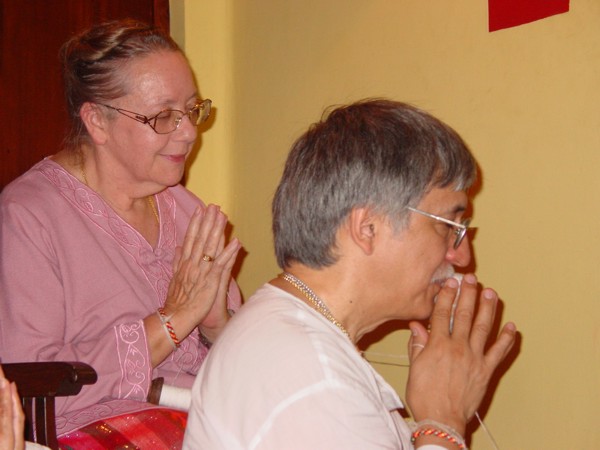 |
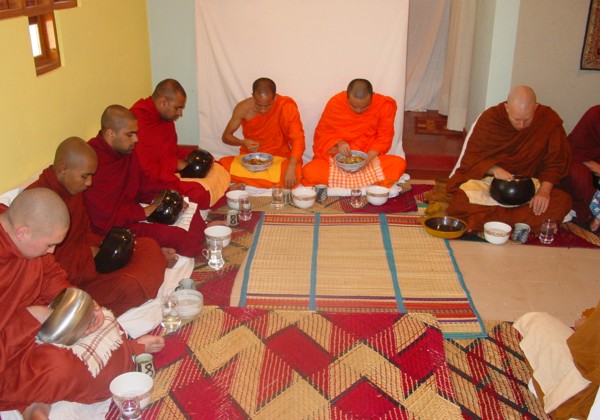 |
||||
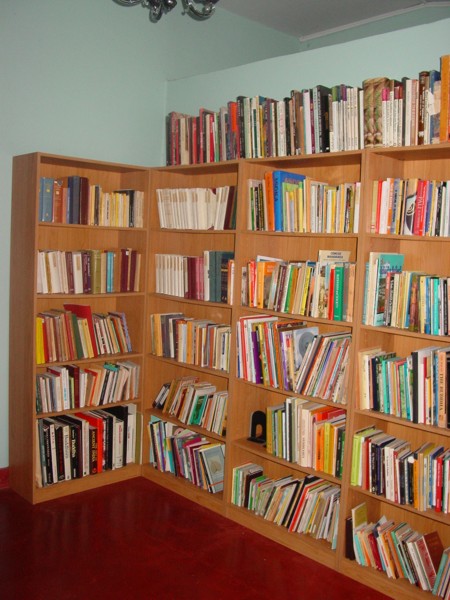 |
|||||
| Click either of the photrs above to see all the photos of the Paritta Ceremony and th Birthday Lunch.
Click the photo at right to see photos of the house wirh our belongings arranged. |
|||||
Counting our Blessings, September 22, 2006
Our shipment arrived with excellent timing--the office chair Ken had gotten in Kandy town had just collapsed. (He was not hurt when it crashed, but it sure startled Visakha!) The wheels on two of the five feet simply snapped off. As in Burma, though, nothing goes to waste. A friend wanted it to combine with another broken one. The end result, we hope, was one working chair.
English classes continue to be engaging. Recently, we've been working with some shorter Jatakas, reading them with the class, using dictionaries for vocabulary questions. (We're planning dictionary exercises so our students can become more efficient in using them.)
While we're counting our blessings, how serendipitous to be able to schedule Visakha's 63rd birthday celebration with the blessing of our house! We have been here for almost a full year, but now that our stuff has come in, it finally looks and feels like we are really living in a home, instead of out of a suitcase. Why should it be a surprise that it was serendipitous? After all, this is Serendib, an old, old name for Ceylon.
Wondering how to mark the occasion, we finally settled on having Maha Paritta chanting on the evening of September 15, Visakha's birthday, and offering lunch to the monks the next day. We opted for two hours of chanting, rather than all night and invited two monks from Subodharama and two from Vajiraramaya, the two bhikkhu training centers where we have classes. Of course, we also wanted Ven. Nyanatusita, the editor of BPS, and the Australian monk staying with him to come. We invited Ven. Upatissa, but he had a previous engagement in Colombo. The Swiss monk, Ven. Sumedha, who resides in a cave near Peradeniya, graciously accepted our invitation, as did two Shan monks studying in Colombo. One of the young monks from Vajiraramaya is Mongolian, so we had six nationalities represented, all chanting in beautiful harmony. If only the world could be so harmonious!
A jaggery peddler, who regularly comes to the door with cakes of delicious palm sugar for sale, happened by just a few days before. We bought enough to make catumadhu, "Buddha's medicine" following the recipe that our Burmese teacher, U Khe Min Da Sayadaw, had taught us in Moji years ago. Mix equal volumes of jaggery, honey, ghee, and (olive) oil and patiently stir over boiling water in a double boiler. It can take hours (We remember the record holder--five hours over a wood fire in Pippa's yard in Chiang Mai!), but it is a very pleasant job. As the oil is absorbed, all the ingredients meld into a smooth, beautiful golden brown taffy. The hot bowl is then removed from the water and must be placed on a wooden board. (Sudden contact with a cold surface will cause the oil to separate out again.) You have to keep stirring a while longer until the the bowl is cool enough to touch comfortably. Then the catumadhu can be poured or spooned into jars. Just a smidgeon is enough to protect the stomach when taking strong medicine or to give energy and strength to an unwell monk or meditator in the afternoon, when ordinary food is not allowed. This was the first time Lily had ever seen such a process, and she was quite taken with it too.
Although we invited our colleagues from Buddhist Publication Society to the house blessing, most of the staff had to go to Colombo for the annual International Book Fair at BMICH, where we had enjoyed our ESL conference mentioned in an earlier report. Although he couldn't come, the chief administrator, Mr. Seneviratne, sent some delicious wattalapan (a traditional Sri Lankan dessert) for us to serve the monks.
In our shipment were the photos of some of the monks we especially respect and regard as teachers--Ven. Nyanaponika,, Ven U Vicitta, Ven. Tamannya, Ven.U Khe Min Da, Ven. U Kawida, and Ven. Kim Cang. Savithri had a snap taken of Ven. Bhikkhu Bodhi in Udawatekelle, sitting on a stone bench where he liked to meditate. We scanned it and printed a large copy, but the color of his robe was too pale. Vasantha, a new member of our Students of the Lotus meditation group, a classmate of Savithri's, who has a photo studio (He used to do all the passport photos for Ven. Bhikkhu Bodhi and regards him as his teacher.) offered to help. He made a professional copy and put it in a matching frame. Ronnie, the basu (carpenter or handyman), helped us get the pictures up. (It is difficult to pound the nails into some parts of the plaster walls.) Now all the venerable photos are hanging above the altar. The side walls are also adorned with beautiful Buddhist hangings. On the wall facing the altar are the two paintings we bought in Laos.
We also reframed the poem Bhikkhu Bodhi wrote for our house blessing in Flint. It hangs just inside the door. Wherever we hang that blessing is home!
Most of our cooking needed to be done in advance, so, while the cole slaw was marinating in the refrigerator, we wanted to get the special spaghetti sauce simmering. Thursday afternoon, Visakha was peeling garlic at the dining table while Ken was in the kitchen chopping vegetables. Suddenly, he let out a sharp cry, and Visakha knew exactly what had happened. We'd gotten used to using the very dull Sri Lankan knives, but now we had our knives from Japan and the States. They are sharp! "How badly did you cut yourself?" she asked. Then she heard Lily's sharp gasp--she was obviously agitated. It must have been bad. "I don't think a band-aid will do," Ken answered. "Bring me the clean white towel on the stool in the shower." When Visakha took the towel to the kitchen, Ken had his hand under the running water, holding ice Lily had given him, and the sink was red with blood. Ken wrapped his finger tightly in the towel and said, "Maybe I need to go to the hospital and get it stitched." The finger was seriously cut, but, happily, it wasn't amputated!
.
We tried calling a tuk-tuk, but none of our usual guys was free. Lily ran to the corner and brought one back immediately. Charles was puttering around the garden next door in his shorts, but, as soon as he heard the commotion, he threw on some slacks and called a doctor. As we got into the tuk-tuk, he informed us that we could see the doctor in about a half-hour. "I don't want to wait," Ken said, applying pressure to his finger to stop the bleeding. "Let's go to the hospital emergency room." Charles directed the driver, and in five minutes, we were at the same private hospital where Visakha had had her ear flushed several months ago. Charles was very helpful. Although the hospital staff spoke English, the process was much smoother, faster, and easier in Sinhalese.
Emergency had several little curtained-off cubicles, and Ken was ushered into one near the door by a nurse in a crisp white cap and uniform, not seen anymore in the States. When the finger was unwrapped, the bleeding from the deep cut had pretty much stopped. A doctor wearing a blue sari quickly arrived, examined the finger, and ordered a shot to numb the finger so she could stitch it up.
While Ken was waiting for treatment, Visakha watched the people come and go--orderlies in spic and span white uniforms, women in saris and salwar suits with children, Muslim women with their heads covered, and even a family with two women in black burkas holding the hand of a mischievous little girl in a pink pinafore. A monk came in with a wound on his arm. There was a steady stream of people, but it was calm and quiet.
Ken's cut was clean, but the nurse cleaned it further with hydrogen peroxide, and the doctor gave him his stitches in short order. The finger was carefully wrapped, and we got a prescription for pain medicine (Ibuprofen) to be filled at the hospital pharmacy. The nurse asked for one hundred rupees ($1.00) for the surgery. Charles and Visakha made their way to the pharmacy and submitted the papers. The pharmacists behind the counter had a number of people to take care of, so they waited. It looked like nothing whatsoever was happening, when, suddenly, the medicine was handed through over. The charge? Five hundred forty rupees ($5.40). Round-trip fare for tuk-tuks, which were as fast as an ambulance, was 150 rupees ($1.50). Thus, the total bill was less than $8.00. How could we complain? We have health insurance, but it is 1000 dollar deductible, so, with luck and a little more mindfulness, we may never need it. Nobody ever wants to use their insurance, right!
When we got back to our house, everybody was waiting to find out what had happened. Though it was past her usual quitting time, Lily insisted on chopping the rest of the vegetables, forbidding either of us to touch a knife. After she left for home, however, Ken discovered that he'd forgotten the onions, so Visakha tearfully peeled and chopped a bowl full of pungent little purple bulbs.
Being thoroughly ignorant of how ceremonies are done in Sri Lanka, we gratefully turned to Savithri and her entire extended family for advice and preparations. One unique feature of Sinhalese culture is that the ceiling over the chanting monks needed to be hung with white cloth in a very special arrangement. It had to be divided into 9 segments, with na (the national tree of Sri Lanka [photo in a previous report]) and areca (betel) leaves and coconut flowers hanging from each segment. While we were teaching, one of Savithri's brothers came, put hooks in the ceiling, stretched the wire and string, arranged the cloth (two of Ken's dhotis from India) and hung the leaves and flowers. It took all morning, but the result was very beautiful. We speculated that the decoration might have originated from the fact that woven palm and grass roofs, common in rural Sri Lankan houses, were dusty and might harbor insects, lizards, and even snakes.
When the monks arrived, Charles and Ken washed their feet before they came into the house. The first to arrive were two Shan monks from Colombo. They would be staying in the guest room. We eagerly caught up on news of mutual friends, the border, and Shan State. This was the second time Ven. Khemacara had been here. We had met Ven. Sena first in Bangkok, but then met him again in Fang, where we had enjoyed so much gracious Shan hospitality. We recalled some of the delicacies we'd had there, particularly the fried black donuts made of sticky rice flour and jaggery. He had also come with us last year with Ajahn Wisanu on our trip to Kandy. He has only a few more months of study in Sri Lanka, and next year will be going either to London with Ajahn Wisanu or to Buddhagaya, where the Shan are establishing a monastery. Perhaps some of the monks there will be able to join the classes in Kolkata in March. We also discussed the possibility of a short but intensive English course for some of the Shan monks in Colombo.
The monks from BPS arranged their own three-wheeler, but we took care of the others. Asoka, whom we hire most often, brought the monks from Vajiraramaya. We asked Krishantha to fetch Ven. Sumedha, not only because finding the way to his cave was tricky, but also because, as a Buddhist, he would take special care to accompany the monk up and down the one hundred steps he has to navigate whenever he goes out.
Ven. Dhammavasa, abbot of Subodharama, and another monk arrived in the temple van with the relic. Ken carefully brought it into the house, placed it in the special altar, which Savithri's brother had prepared by fashioning a bamboo frame and covering it with white cloth. Then he lit the oil lamp in front of it.
We also used, for the first time, the tall brass lamp with a rooster on top that Savithri had left in the house and which we had gotten newly polished. It seems that every Sri Lankan home has one, but it quietly loses its lustre between events.
The chanting by the ten monks--four Sri Lankan, two Shan from Upper Burma, one Dutch, one Mongolian, one Swiss, and one Australian, was beautiful and moving. Paritta is chanted on auspicious occasions for a blessing, but its meaning is also protection from danger and adversity.
There was a thread from our first image, the Thai Buddha we got almost thirty years ago in Loei, near the Mekong. The thread ran from the Buddha statue to the monks and then passed to the lay people, so that we were all holding it while the monks chanted. In addition to Ratana, Mangala, and Metta Suttas, the chanting included Jayamangala Gatha (Buddha's Eight Great Victories), the Twenty-eight Buddhas, and others we have not yet memorized. Click here to access a site where you can read all the Paritta.
Our student from Mexico, Angarika Luis Filipe, who plans to ordain at Vajiraramaya, came and took part with the rest of us lay folk. He is studying Sinhalese and Pali, as well as English with us, and followed the chanting with a "Mirror of the Dhamma" booklet.
In Ven. Sumedha's eloquent Dhamma talk, he expressed an appreciation for the richness of all the Buddhist art so carefully arranged around the house.
When the ceremony was finished, Ven. Dhammavasa poured a little lustral water in our cupped hands for us to drink. Then he gave us all special thread for tying on our wrists as a sign of blessing and protection.
Ken mindfully carried the relic to the van and returned it to Ven. Dhammavasa. After all the monks had left (except the Shan monks, of course), we continued preparations for the next day's feast. Lily and her friend Margaret cooked virtually all night because the days are too hot, and our refrigerator is too small.
Early the next morning we had Shan-style chanting. After metta meditation, we offered the monks a simple breakfast of rice, dahl, and Charles' tasty green porridge.
We were pleased that Saul, the layman who has been staying in the meditation center next to the Forest Hermitage in Udawattekele, the National Forest in the heart of Kandy, accompanied the two monks for lunch. We'd met him earlier and knew that he had been in Sri Lanka for almost a year studying Dhamma and meditating. During a lull, Saul told us that he's going back to Israel shortly--a kibbutz wants to establish a meditation center, and he will be working on that project. Evidently, there is considerable interest in Buddhism and Vipassana in Israel right now. We recalled Rabbi Michaels in Flint saying that all the most brilliant Jews were becoming Buddhists. Perhaps some exaggeration there?
Lunch was delicious with too many dishes to count. We used virtually all our serving bowls and cups from Japan and the States. In addition to our pasta, with freshly-grated Parmesan and Romano cheeses, there were four kinds of rice, cashew curry, eggplant curry, dry potato and channa curry, dahl, soup, cole slaw, green salad, and much more. One slightly sweet curry was made from ambarella, which in English is hog plum.* Despite the name it was surprisingly good. Desserts included the wattalapan, ice cream and fruit salad, and a scrumptious bread pudding from the younger son Savithri and Manel, pasty chef at Topaz Hotel (photo in previous report). Some of the monks enjoyed Kenyan coffee, one of Visakha's birthday gifts.
After lunch we presented each monk with dana--a monk's umbrella, yellow towels, a box of tissue, soap, toothpaste, a toothbrush, incense, a jar of catumadhu, a bar of dark chocolate--all arranged, Thai-style, in a useful red bucket. Savithri gave each monk a cloth napkin and a box of biscuits. She also made a special offering to Ven. Sumedha of all eight requisites.
We were very happy to have a chance to talk with all the monks and for them to talk with each other. In every way it was edifying, with lots of Dhamma and just enough ritual to be beautiful.
Our official photographer was the Munesinghes' grandson, Sajitra. He lives in Colombo but has been staying with them to study for his A level exams in the peace and quiet that only Kandy can provide. He was scheduled to return home on Thursday, but as soon as we commented that we would be sorry for him to miss the ceremony, he called his folks and arranged make-up classes. He is studying Japanese in hopes to go to Japan to work with his uncle there. He is a mature fifteen-year-old, and we really appreciated his help. He is serious about photography and took almost all the really fine photos here.
 |
 |
||||
 |
|||||
| Click either of the photrs above to see all the photos of the Paritta Ceremony and th Birthday Lunch.
Click the photo at right to see photos of the house wirh our belongings arranged. |
|||||
| Wednesday, September 20, Ven. Upatissa came for lunch. It was a lovely day! |
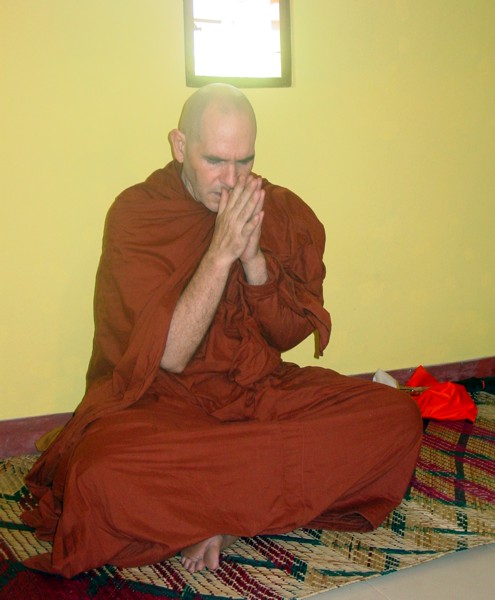 |
|
| Friday, September 22, Ven. Shi Xingpu, the Chinese monk in Colombo whom Ven. Nyanatushita introduced us to many months ago, came to Kandy to visit us. He has finished his study and successfully defended his thesis. He was free and so much more relaxed than we had ever seen him. He will be returning to China while we are in India. He has invited us to China, where we very well may go someday, or we may meet him in Singapore. | 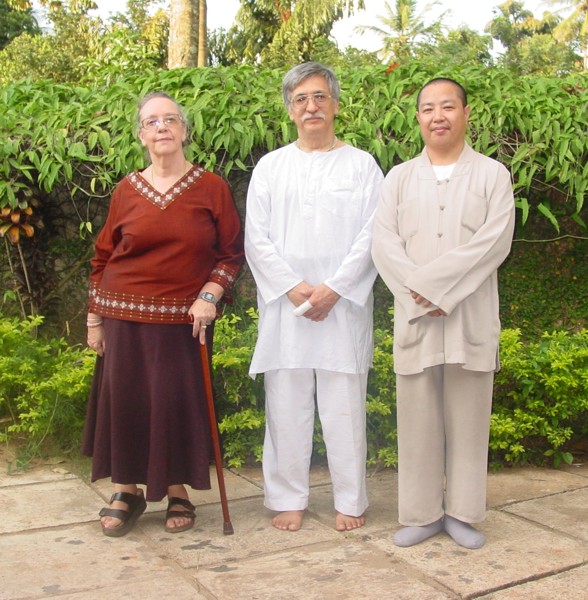 |
||
Next Tuesday, we are off to India--Mumbai and Nagpur--for the fiftieth Anniversary celebration of Dr. Ambedkar's conversion to Buddhism. It was expected that 350,000 to 500,000 Dalits and Tribals would betaking refuge this year, but the ceremony in Mumbai has been postponed to December. We're not sure what will happen in Nagpur. Our next report should tell you.
| * |
From "Innvista," <http://www.innvista.com/health/foods/fruits/otherex.htm> Ambarella (Sinhalese), Brazil plum, hog plum, Golden apple, Otaheite-apple/Tahitian quince/vi (Tahiti), Jew plum (Jamaica), pomme cythère/évi (French), Cytherea/Tahiti-Apfel (German), cirnela dulce (Cuba), amara (Hindi), kedongdong (Malay/Indonesian), ma kik farang (Thai), caja-manga (Brazil), jobo de la India (Venezuela) (Spondias dulcis, formerly S. cytherea--Family Anacardiaceae) Ambarella is related to the mombin, and native to the Society Islands; but it is now widely distributed throughout tropical and subtropical regions of both hemispheres, especially southeast Asia and the Pacific Islands. It is cultivated, but not on a large scale. The plum-like fruits are grayish-orange and grow in clusters of two to ten fruits. Each fruit contains a single seed, much like an avocado, and is surrounded by a yellowish pulp which is pleasantly sour. The taste is a mix of apple and pineapple, but the aroma is sometimes resinous and pungent. Although the fruit is popular in the West Indies, it actually originated in Polynesia and is occasionally exported only during the winter. The unripened fruits are often pickled or used in soups, while the ripened fruits are used in sauces, drinks, and preserves. |
||